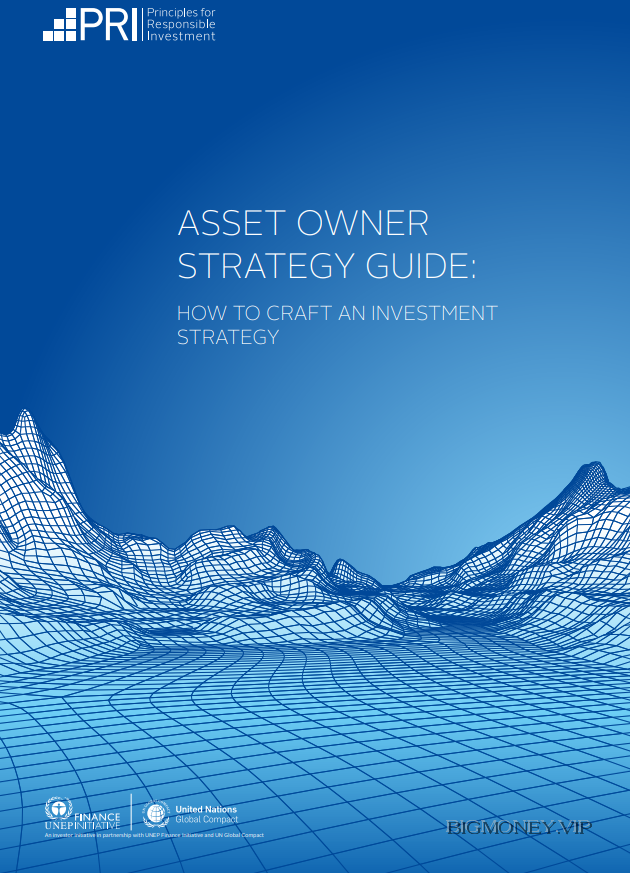ASSET OWNER STRATEGY GUIDE: HOW TO CRAFT AN INVESTMENT STRATEGY by Xander den Uyl and Kris Douma

FOREWORDS
LONG-TERM RESPONSIBLE
INVESTMENT STRATEGIES ARE HERE
TO STAY
When the PRI published its discussion paper on asset owner
investment strategy— Crafting an Investment Strategy—
they declared that even though many asset owners have
made commitments to responsible investment, there is still
insufficient work to embed sustainability into institutional
investment strategy.
Asset owners need to get back on the “front foot” when
it comes to their investment strategy. While the global
macroeconomics and political economy continue to send
mixed signals, it’s more critical than ever that asset owners
demonstrate a sound and considered investment strategy
that takes environmental, social and governance (ESG)
issues into account to maximise long-term investment
performance and better manage risk and, often, beneficiary
expectations.
Since the discussion paper was published, there have been
new industry initiatives that support consideration of ESG
issues. For example, asset owners now have guidance
from the recommendations of the Financial Stability Board
(FSB) Task Force on Climate-related Financial Disclosures
(TCFD). The TCFD recommendations are designed to help
companies and investors understand and manage climate-
related risks.
When it comes to industry players leading by example, the
world’s largest asset owner GPIF recently announced that
they had included ESG in their investment principles. Such
an announcement sends a strong signal about the systemic
importance of ESG as a creator and preserver of value.
Alongside these developments, the market momentum
for a more long-term responsible investment approach
seems unstoppable. Having followed the ESG / SRI market
for more than a decade, the past 18 months has felt more
like a tipping point, the time when responsible investment
finally arrived onto the front pages of the financial press and
became “mainstream.”
Given the direction of travel, a sound investment strategy
is one that assesses long-term sustainability issues and
understands how global megatrends will shape our future
investment environment. It is not a tick-box exercise but
rather, a fundamental starting point to investment decision-
making that improves risk management and maximizes
returns for current and future generations of beneficiaries.
EVOLVING INVESTMENT STRATEGY
CONSIDERATIONS FOR BOARD
MEMBERS AND EXECUTIVES
Over the last few years, it has become obvious that taking
material ESG issues into account in investment strategies,
decisions and active ownership is not against, but an
integral part of an investor’s fiduciary duty, which requires
investors to act in the interest of the ultimate beneficiary.
This requires that responsible investment and incorporation
of ESG issues is not a ‘nice to have’ overlay, but should be
firmly integrated in an asset owner investment strategy.
Asset owners, who sit at the top of the investment chain,
have it in their power to communicate to managers and
other stakeholders how critical ESG is to addressing
systemic risks such as climate change. Climate change
presents serious material risks for investment portfolios,
and, in the wake of the Paris Agreement, it’s vital that
investors engage with the companies in their portfolios to
see how they plan to transition to a low carbon world.
The recommendations by the Financial Stability Board
(FSB) Task Force on Climate-related Financial Disclosures
(TCFD), announced last June, provide a framework for
ensuring transparency on how companies are dealing
with climate change. We urge all investors to adopt the
recommendations.
Given their long-term investment horizon, asset owners
are well placed to use ESG factors to build value for
their beneficiaries. In order for this to happen, it is vital
that asset owners develop clear ESG investment goals
and ensure those goals are supported throughout their
organisation. While progress on ESG-focused investing is
not materializing as quickly as we would like, the signals that
we are seeing in the market tell us that things are moving in
the right direction.
At the same time new challenges arise. Increasingly,
beneficiaries and society in general expect investors to
contribute to ‘broader objectives of society’, as they were
originally called in the PRI preamble. The UN Sustainable
Development Goals, launched in 2015, provide a global
framework for these broader objectives of society.
Investment strategies move beyond incorporation of ESG
in Risk and Return and include a third ‘R’: asset owner
expectations of Real-world impact, aligned with the SDGs.
We are living in exciting times, when asset owner strategies
are required to focus on managing ESG-risks, seeking
sustainable investment opportunities to create good
financial returns and contribute to solutions for major
problems in our global society. This Strategy Guide hopefully
helps asset owners on that journey.
ASSET OWNER STRATEGY GUIDE: HOW TO CRAFT AN INVESTMENT STRATEGY by Xander den Uyl and Kris Douma




